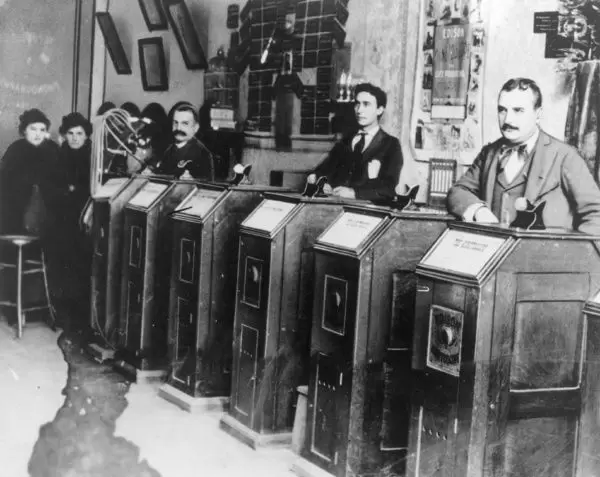
On May 9, 1893 the first public demonstration of the kinetoscope was held at the Brooklyn Institute of Arts and Sciences. Featuring three workers pretending to be blacksmiths, the film was among the first glimpses into motion pictures.
With the vacation upon us already and the pandemic scene relenting a bit, one of the activities that most families tend to do over the weekend is visiting a theatre to watch a new movie. Even though motion pictures are a multi-billion-dollar industry in the world today, they have been around only since late in the 19th Century. By the end of that century. the concept of moving images as entertainment was picking up. Magic lanterns had been around for generations and these devices employed glass slides with images that were then projected. We had looked at how pioneering photographer Eadweard Muybridge invented the zoopraxiscope in this column about two months back. Muybridge’s zoopraxiscope projected a series of images, which were printed on a rotating glass disc, in successive phases of movement.
Muybridge meets Edison
It isn’t clear as to when American inventor and businessman Thomas Alva Edison’s interest in motion pictures began. Even though some argue that he was already interested for years, it is obvious that Muybridge’s visit to Edison’s laboratory in West Orange in February 1888 convinced the latter to invent a motion picture camera.
Muybridge suggested that they collaborate and work together to combine the zoopraxiscope with Edison’s phonograph – a device for the recording and reproduction of sound. While Edison was clearly intrigued by the idea, he decided against the partnership, maybe because he could see that the zoopraxiscope wasn’t the best way of recording motion.
Calls it kinetoscope
Always an entrepreneur, Edison decided to protect his future inventions by filing a caveat with the Patents Office in October 1888. He described his ideas for a machine that would record and reproduce objects in motion, calling it a device that would “do for the eye what the phonograph does for the ear”. He named this yet to be invented device as a kinetoscope, by combining the Greek words for “movement” and “to watch” kineto and scopos.
Much of the credit for the design of the kinetoscope actually goes to Edison’s assistant, William Kennedy Laurie Dickson, an accomplished photographer. Tasked with inventing Edison’s kinetoscope in June 1889, Dickson, assisted by Charles A. Brown, carried out a lot of experimentation to turn the concept into reality.
Celluloid film to the rescue
After the initial attempts proved futile, Edison’s team changed direction to that of others in the field. Edison had encountered French physiologist Etienne-Jules Marey, who had produced a sequence of images by utilising a continuous roll of film in his chronophotographie, in Europe and this put them onto their new track
By now, the inventive process was being delayed by the lack of film rolls of requisite length and durability. Edison’s experiments started using emulsion-coated celluloid film sheets that were developed by photographic pioneer John Carbutt. When the Eastman. Company started producing its own celluloid film, Dickson and his new assistant William Heise got it in large quantities and set about working on their machine.
Means of seeing motion pictures
Dickson had the prototype ready by 1891 and the device doubled up both as a camera and a peep-hole viewer. On August 24, 1891 they applied for a patent for the kinetograph (the camera) and the kinetoscope (the viewer) and the device was completed by 1892.
Consisting of an upright wooden cabinet that was four feet high, the viewer had to look into a peep-hole at the top of the cabinet to see the motion picture. The first public demonstration of Edison’s films featured three of his workers pretending to be blacksmiths and was held at the Brooklyn Institute of Arts and Sciences on May 9, 1893. By 1894. hundreds of people often lined up in parlours housing these devices to pay 25 cents (over $7 in today’s money) and watch five reels.
In the years that followed, Dickson left Edison to be a part of the group that formed the American Mutoscope and Biograph Company: Edison sued that company in 1898 for infringing on his patent for the kinetograph; and the two companies started working together from 1909 until Edison’s company left the film industry in 1918. By then, Dickson, Edison, and the kinetoscope had more than just provided a glimpse of a new form of media – the motion pictures.
Picture Credit : Google




